Pulmonary Function Test – Purpose, Procedure, and Risks

INTRODUCTION
Respiration, as the term is generally used, includes two processes: external respiration, the absorption of O2 and removal of CO2 from the body as a whole; and internal respiration, the utilization of O2 and production of CO2 by cells and the gaseous exchanges between the cells and their fluid medium.
PARTIAL PRESSURES
Unlike liquids, gases expand to fill the volume available to them, and the volume occupied by a given number of gas molecules at a given temperature and pressure is (ideally) the same regardless of the composition of the gas. Therefore, the pressure exerted by any one gas in a mixture of gases (its partial pressure) is equal to the total pressure times the fraction of the total amount of gas it represents.
THE RESPIRATORY SYSTEM
The respiratory system is made up of a gas-exchanging organ (the lungs) and a “pump” that ventilates the lungs. The pump consists of the chest wall; the respiratory muscles, which increase and decrease the size of the thoracic cavity; the areas in the brain that control the muscles; and the tracts and nerves that connect the brain to the muscles.
At rest, a normal human breathes 12 to 15 times a minute. About 500 mL of air per breath, or 6 to 8 L/min, is inspired and expired. This air mixes with the gas in the alveoli, and, by simple diffusion, O2 enters the blood in the pulmonary capillaries while CO2 enters the alveoli. In this manner, 250 mL of O2 enters the body per minute and 200 mL of CO2 is excreted.
THE BRONCHI & THEIR INNERVATION
His trachea and bronchi have cartilage in their walls but relatively little smooth muscle. They are lined by a ciliated epithelium that contains mucous and serous glands. Cilia are present as far as the respiratory bronchioles, but glands are absent from the epithelium of the bronchioles and terminal bronchioles, and their walls do not contain cartilage.
INSPIRATION & EXPIRATION
The lungs and the chest wall are elastic structures. Normally, no more than a thin layer of fluid is present between the lungs and the chest wall. The lungs slide easily on the chest wall, but resist being pulled away from it in the same way that two moist pieces of glass slide on each other but resist separation. The pressure in the “space” between the lungs and chest wall is sub atmospheric.
LUNG VOLUMES
The amount of air that moves into the lungs with each inspiration (or the amount that moves out with each expiration) is called the tidal volume. The air inspired with a maximal inspiratory effort in excess of the tidal volume is the inspiratory reserve volume. The volume expelled by an active expiratory effort after passive expiration is the expiratory reserve volume, and the air left in the lungs after a maximal expiratory effort is the residual volume. Normal values for these lung volumes, and names applied to combinations of them.
RESPIRATORY MUSCLES
The diaphragm has three parts: the costal portion, made up of muscle fibers that are attached to the ribs around the bottom of the thoracic cage; the crural portion, made up of fibers that are attached to the ligaments along the vertebrae; and the central tendon, into which the costal and the crural fibers insert. The central tendon is also the inferior part of the pericardium. The crural fibers pass on either side of the esophagus and can compress it when they contract. The costal and crural portions are innervated by different parts of the phrenic nerve and can contract separately. For example, during vomiting and eructation, intra-abdominal pressure is increased by contraction of the costal fibers but the crural fibers remain relaxed, allowing material to pass from the stomach into the esophagus.
GLOTTIS
The abductor muscles in the larynx contract early in inspiration, pulling the vocal cords apart and opening the glottis. During swallowing or gagging, a reflex contraction of the adductor muscles closes the glottis and prevents aspiration of food, fluid, or vomitus into the lungs. In unconscious or anesthetized patients, glottic closure may be incomplete and vomitus may enter the trachea, causing an inflammatory reaction in the lung (aspiration pneumonia).
SUMMARY
The pressure exerted by any one gas in a mixture of gases is defined as its partial pressure. Partial pressures (P) of gases in air at sea level are as follows: Po2 = 149 mm Hg; Pco2 = 0.3 mm Hg; PN2 (including other gases) = 564 mm Hg.





